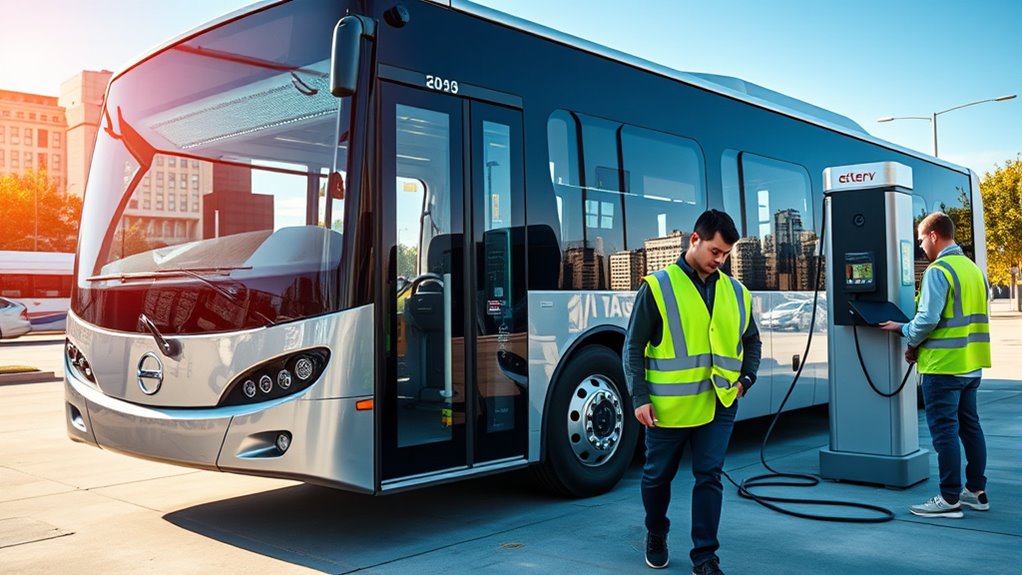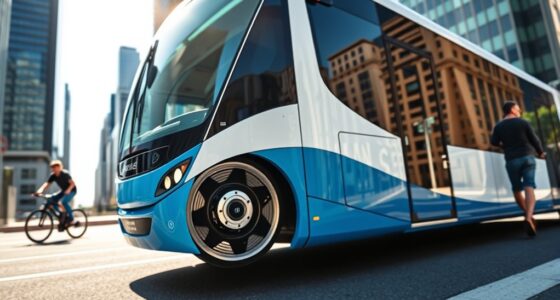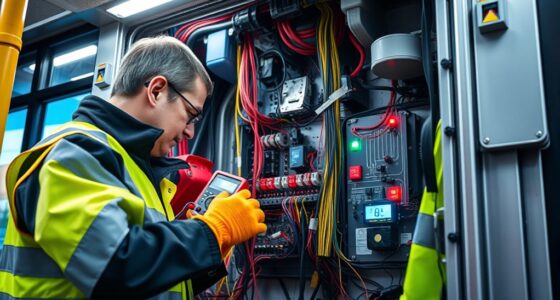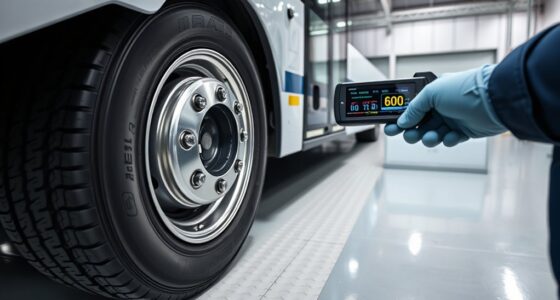Regular software updates for electric buses are essential to enhance efficiency, safety, and performance. They optimize energy use, extend battery life, and keep systems responsive. Updates patch security vulnerabilities, reducing cyber risks, and help avoid costly repairs through predictive maintenance. They also guarantee your fleet meets evolving standards and supports advanced features like V2X communication. Staying current with updates keeps your buses reliable, safe, and environmentally friendly—if you want to discover how these updates benefit your fleet further, keep exploring.
Key Takeaways
- Regular updates enhance vehicle safety, performance, and energy efficiency through calibrated systems and real-time data integration.
- They patch cybersecurity vulnerabilities, protecting against hacking and data breaches.
- Software updates ensure compliance with evolving safety standards and regulatory requirements.
- Updates enable predictive maintenance, reducing repair costs and vehicle downtime.
- They support future-ready features like V2X communication and fleet management, improving operational flexibility.
Enhancing Energy Efficiency and Driving Range
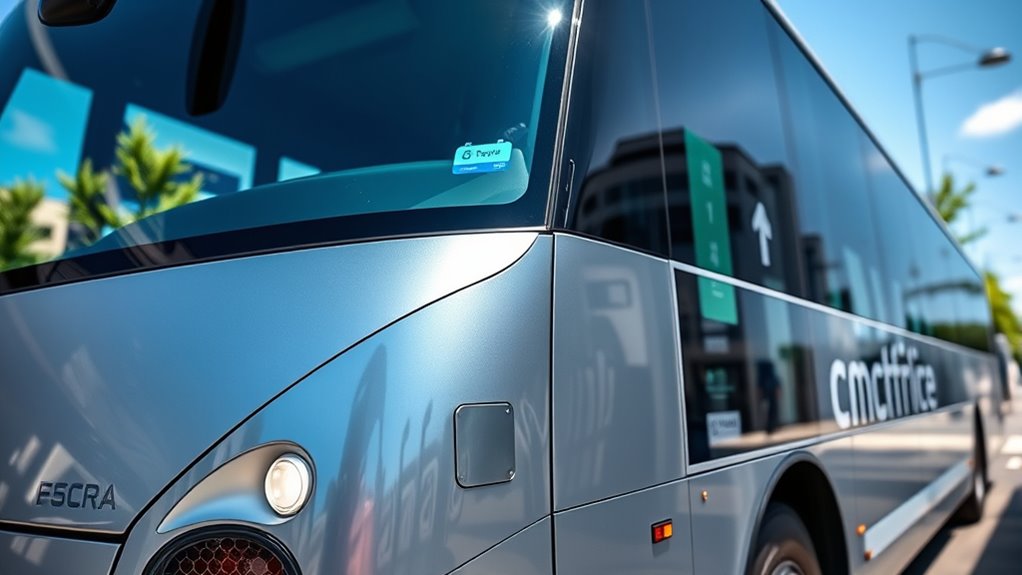
To enhance energy efficiency and extend the driving range of electric buses, software updates play a crucial role. Dynamic modeling tools like EVI-EDGES and BetterFleet™ simulate routes considering topography, weather, and schedules to accurately predict energy needs.
Manufacturer efficiency claims, such as 1.17 kWh/km, often underestimate real-world consumption by 26–41%, especially on complex routes with elevation changes and traffic. Precise software calibration improves motor control and regenerative braking, capturing more kinetic energy and reducing waste.
OTA updates refine battery thermal management and optimize subsystem interactions, boosting overall efficiency. These software-driven adjustments help you avoid underestimating infrastructure needs, lowering long-term energy costs, and preventing costly upgrades.
Regular updates ensure your fleet operates closer to its true energy potential, maximizing range and operational savings.
Improving Vehicle Responsiveness and Performance
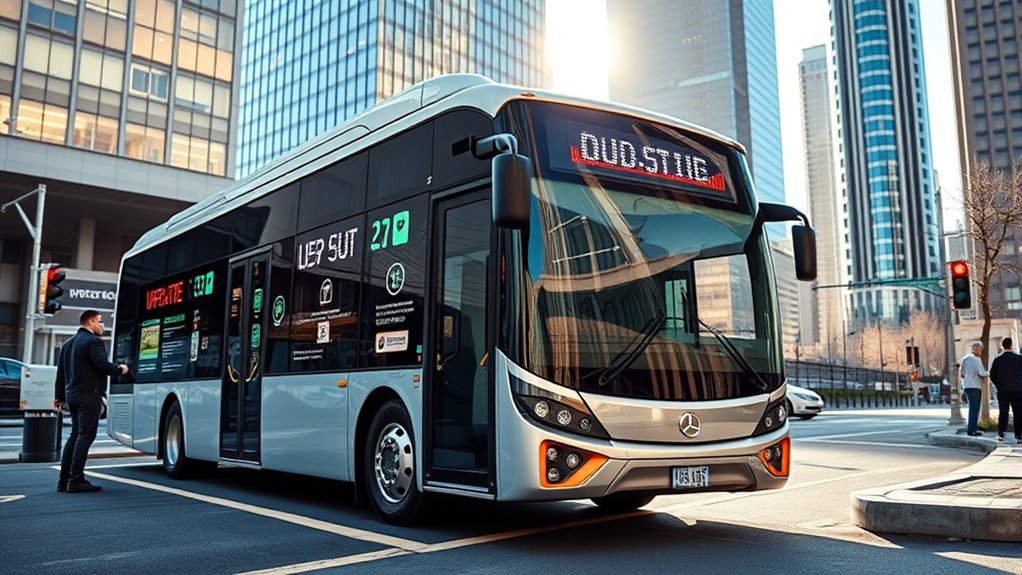
Ever wonder how software updates can make your electric buses more responsive and perform better in everyday operations? These updates enable real-time data integration, giving you better situational awareness and quicker decision-making. Vertical storage solutions can be incorporated into fleet management to optimize space for maintenance equipment and spare parts, enhancing operational efficiency. They support predictive maintenance, catching issues early so buses stay responsive and avoid unexpected breakdowns. Advanced software also allows for dynamic route adjustments based on current conditions, improving service reliability. By optimizing performance through traffic and environmental data, updates ensure buses run efficiently. They reduce downtime by proactively addressing maintenance needs. Additionally, continuous performance tracking helps you fine-tune operations, and charging optimizations keep buses ready to go. Research supports 16PF and other personality assessments in understanding team dynamics, which can further enhance fleet management and staff coordination. Moreover, leveraging software-based diagnostics can significantly improve troubleshooting and reduce repair times, keeping your fleet operating smoothly. Regularly updating software also prepares your fleet to adapt to changing regulations, ensuring compliance and safety. Overall, these updates enhance responsiveness, making your fleet more agile, reliable, and capable of meeting passenger demands seamlessly.
Keeping Safety Systems Up-to-Date
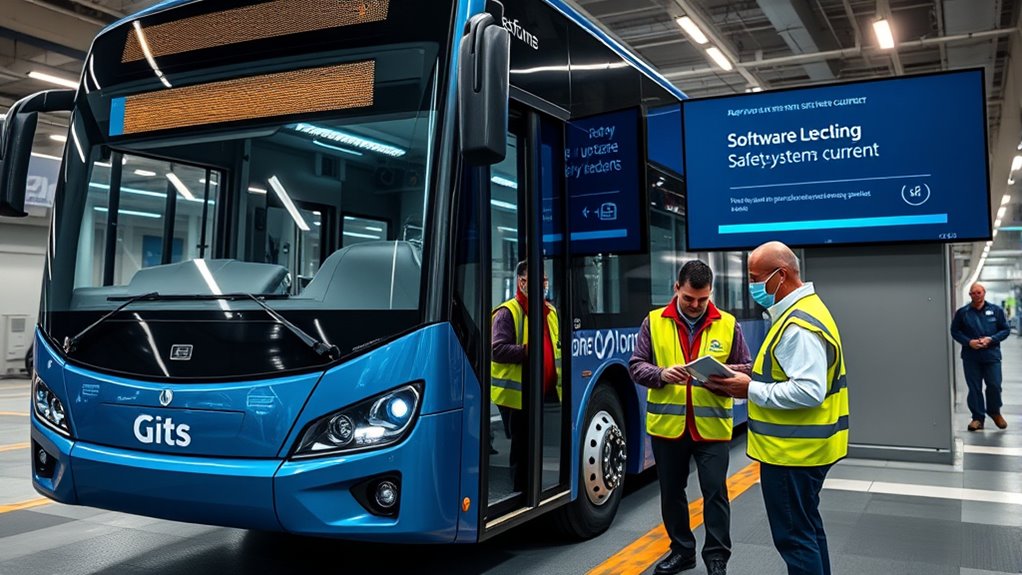
Regular software updates play a vital role in keeping your safety systems reliable and effective. By updating collision avoidance systems, you guarantee sensors remain calibrated, reducing false alarms and improving detection of pedestrians, cyclists, and vehicles. These updates also expand detection zones, providing better protection for vulnerable road users and ensuring compliance with evolving safety regulations like the EU GSR.
Additionally, updating battery management systems helps prevent overheating and thermal runaway, minimizing fire risks. Regular patches for safety standards such as UNECE R100/R136 guarantee your vehicle remains compliant and safe.
Evolving software enhances occupant protection by refining crash response algorithms and emergency systems. Keeping these safety features current ensures your electric bus delivers maximum protection, responds accurately in emergencies, and meets all regulatory requirements. Ethical hacking principles can also be applied to identify vulnerabilities in your vehicle’s software, ensuring a proactive approach to cybersecurity risks.
Addressing Cybersecurity Vulnerabilities
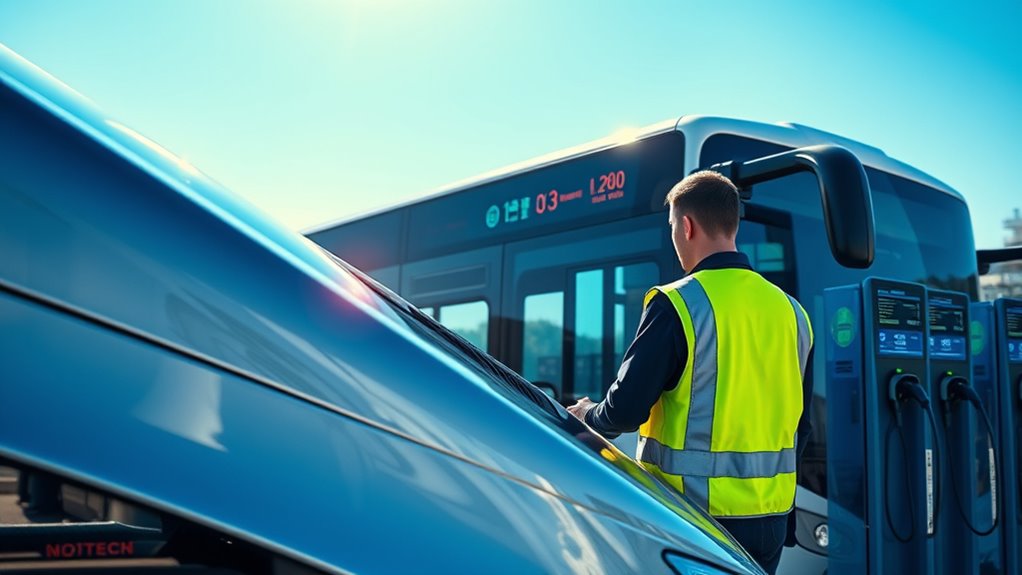
Addressing cybersecurity vulnerabilities in electric buses is crucial as these vehicles become increasingly connected and software-dependent. You need to recognize that communication protocols like CAN can be exploited by unauthorized access, risking operational safety.
The complexity of modern software systems introduces more attack points, especially with extensive data exchanges between buses and external systems. Diverse designs available to enhance indoor aesthetics can inspire the development of more secure and resilient hardware components in vehicle systems. Moreover, integrating AI security technologies can further strengthen defenses against emerging cyber threats. Implementing secure communication protocols is essential to prevent malicious breaches and safeguard sensitive data.
Physical access points, such as OBD ports, can also serve as entry points for cyber threats.
Interconnected systems within the vehicle and with external networks create multiple vulnerabilities. To protect your fleet, you must implement measures like encryption, secure network architecture, and regular software updates.
These updates patch security gaps, reducing the risk of hacking, data theft, or even safety compromises. Staying proactive in cybersecurity is essential for safe, reliable electric bus operation.
Additionally, understanding Private Placement Equity Markets can help secure funding for necessary cybersecurity upgrades and infrastructure improvements, ensuring that investments align with long-term safety and innovation goals.
Reducing Maintenance Costs and Downtime
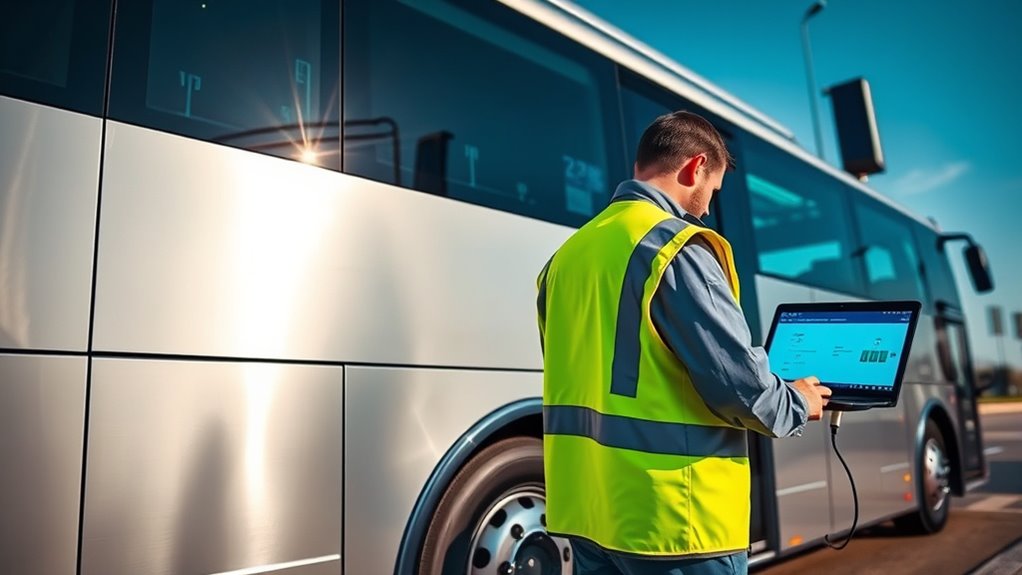
Implementing regular software updates not only enhances cybersecurity but also plays a vital role in reducing maintenance costs and minimizing downtime for electric buses. These updates enable predictive maintenance by detecting mechanical issues early with AI algorithms, preventing costly repairs and unexpected breakdowns. They improve component longevity by managing charge cycles, reducing battery wear, and optimizing thermal and lubrication systems. Software also streamlines diagnostics and automates fault detection, cutting diagnostic time and enabling pre-ordered parts to speed up repairs. Additionally, scheduled maintenance during off-peak hours minimizes service disruptions. By monitoring component health and predicting failures, regular updates keep your fleet on the road longer, lowering operational costs and ensuring consistent availability. Incorporating preventative maintenance strategies into your software protocols can further enhance the reliability and efficiency of your fleet. Regular software updates also support battery management, which is crucial for extending the lifespan of electric vehicle batteries and maintaining peak performance. Furthermore, integrating automated diagnostic tools can help quickly identify and resolve issues before they lead to major failures, ensuring smoother operations. Consistent updates also foster a vibrational alignment with technological advancements, ensuring your fleet remains at the forefront of efficiency. This proactive approach maximizes efficiency and saves you money over the vehicle’s lifespan.
Ensuring Compatibility With Emerging Technologies

As electric buses incorporate advanced technologies like AI, sensors, and automation, guaranteeing their software remains compatible with emerging systems becomes essential. You need to stay ahead by updating software to support new features such as vehicle-to-everything (V2X) communication and real-time data systems. Supporting emotional well-being of operators and passengers during these transitions can also improve overall system adoption and comfort. Standardized smart bus platforms enable seamless operation across different models, but only if software updates keep pace with evolving standards. With software-defined vehicles (SDVs), updates can enhance functionalities without hardware changes. Real-time insights improve fleet management and operational efficiency, while automation helps adapt services dynamically. To avoid compatibility issues, you must prioritize regular updates, coordinate with stakeholders, and leverage innovative solutions like managed charging and integrated communication systems. Additionally, aligning software update schedules with the hours of service for facilities such as retail stores (like Ulta Beauty, Credo Beauty, Sally Beauty, Sephora, and The Detox Market) can facilitate maintenance and deployment, ensuring continuous operation and minimizing downtime. Incorporating standardized protocols can further streamline software integration across various systems and models. Staying informed about latest industry standards is crucial to ensure your electric buses stay efficient, connected, and future-ready.
Supporting Regulatory Compliance and Standards
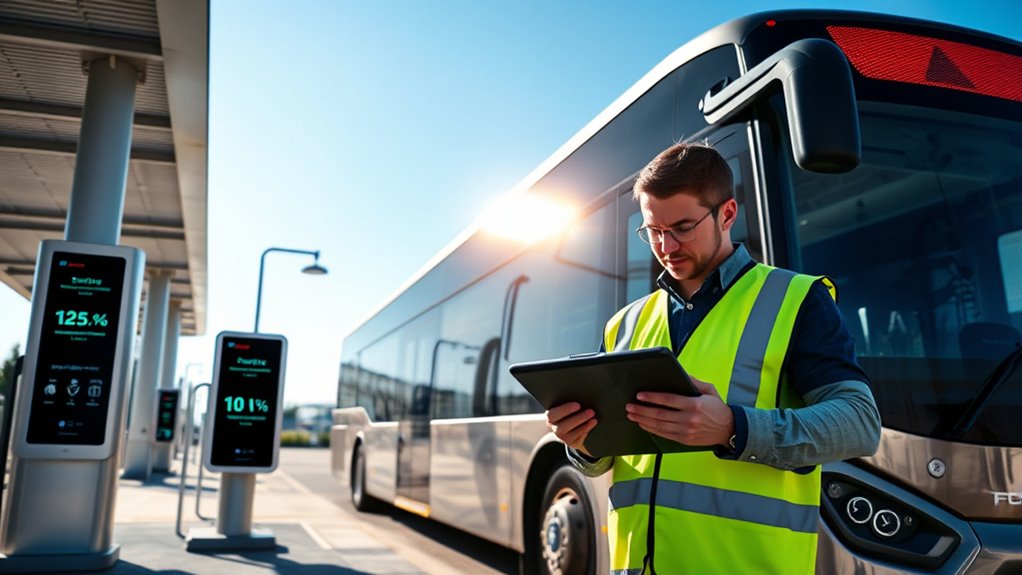
Supporting regulatory compliance and standards is essential for the successful deployment of electric buses, especially as new requirements emerge at federal, state, and local levels. You need to meet federal testing mandates like Altoona evaluations, which verify energy efficiency and safety, and adhere to updated APTA procurement guidelines covering fire suppression, emissions, and propulsion.
Voluntary LoNo-CAP testing can help assess charging systems and energy storage, while resiliency planning guarantees your infrastructure can handle grid dependencies, including redundancy. State mandates, such as California’s ZEB purchases, require compliance documentation, workforce training, and utility collaboration.
Regular software updates help you maintain compatibility with evolving safety protocols, certification standards, and procurement criteria, ensuring your fleet remains compliant, efficient, and prepared for future regulatory changes. Staying informed about new safety standards is crucial for ongoing compliance and operational excellence. Additionally, understanding raw food benefits can support the health and longevity of your electric bus maintenance staff by promoting better overall well-being. Incorporating industry standards into your maintenance procedures ensures consistency and quality across your fleet. Recognizing the importance of Waterparks in family vacations highlights the need for continuous infrastructure improvements and safety protocols to enhance visitor experience and safety.
Enabling Advanced Monitoring and Data Analytics
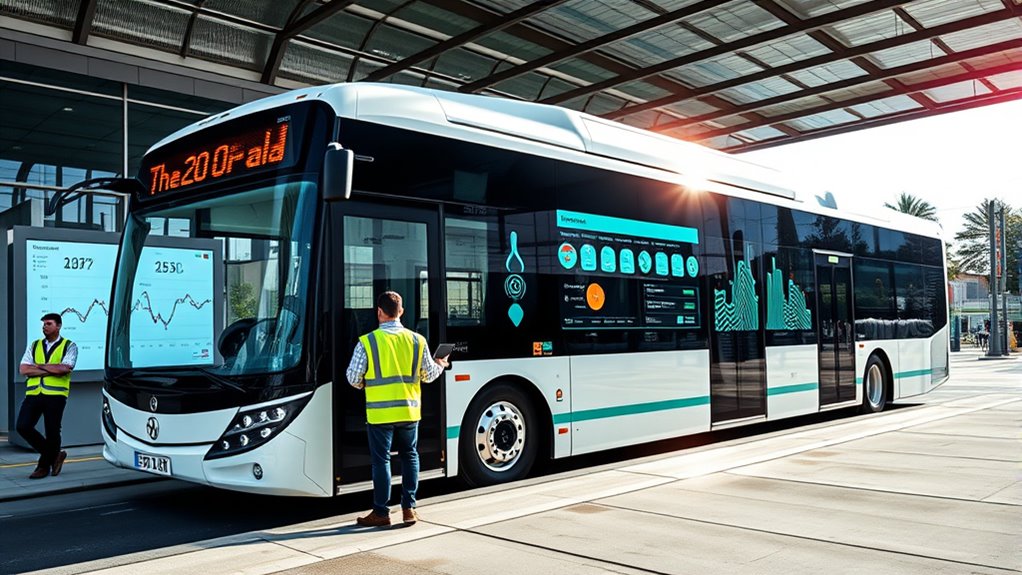
How can you guarantee that your electric bus fleet leverages the full potential of advanced monitoring and data analytics? Regular software updates are essential. They improve data accuracy through better cleansing and validation, reducing errors in the Battery Management System (BMS). Incorporating scientific insights helps ensure that updates are based on the latest research, enhancing reliability and effectiveness. Updates standardize data communication, ensuring compatibility across different systems and vendors, and enable real-time insights into battery performance and fleet operations. Expanding analytical capabilities becomes possible with advanced algorithms that assess battery health and predict degradation, supporting data-driven decisions. Additionally, updates facilitate system interoperability with cloud platforms and various devices, speeding data exchange. These improvements enable you to monitor vehicles in real time, optimize routes, analyze energy consumption, and allocate resources efficiently. Ultimately, regular updates unleash the full potential of your data to enhance operational performance.
Facilitating Predictive Maintenance and Operational Reliability
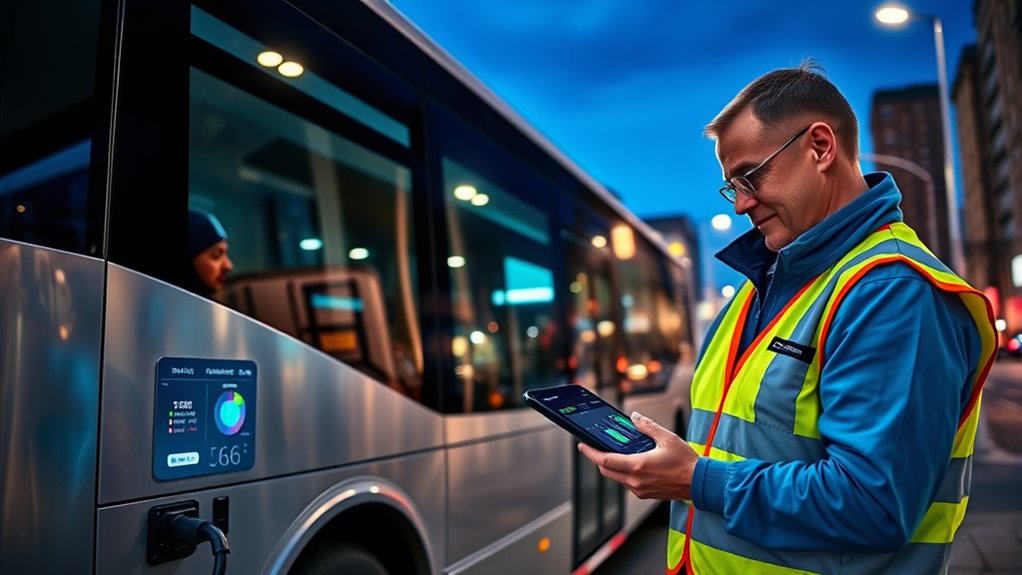
Regular software updates are key to enhancing predictive maintenance and ensuring your electric bus fleet operates reliably. They help reduce vehicle downtime by identifying potential failures early, preventing unexpected breakdowns.
AI algorithms in the system can pinpoint specific components likely to fail, allowing for preemptive replacements that extend vehicle lifespan. These updates improve real-time performance tracking and enable data-driven decisions, optimizing battery health and overall efficiency.
Predictive maintenance minimizes service disruptions, maintaining passenger trust and revenue. Automated scheduling and remote monitoring streamline maintenance tasks, reducing resource use and on-site visits.
Additionally, regular updates support compliance with industry standards and facilitate customized maintenance plans, tailored to different bus models and operational conditions. This proactive approach keeps your fleet dependable and cost-effective.
Promoting Sustainability and Passenger Comfort
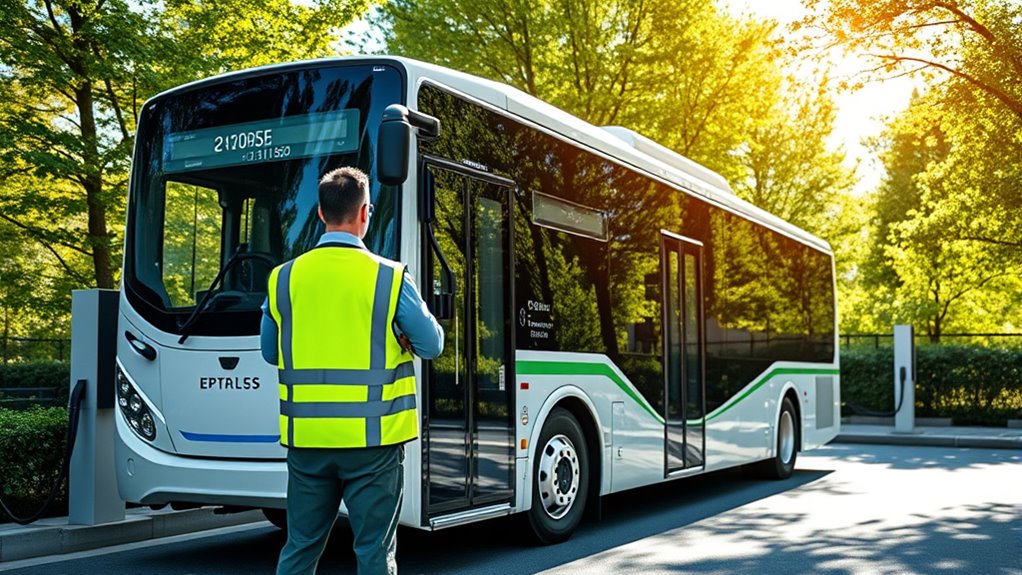
Enhancing sustainability and passenger comfort is a key benefit of the latest advancements in electric bus technology. Regular software updates guarantee smart charging systems adjust power based on grid demand, maximizing renewable energy use and reducing strain.
Vehicle-to-grid capabilities let buses return energy during off-peak times, stabilizing supply and boosting renewable storage. Dynamic load balancing prevents overloads, while lower energy consumption per mile aligns with decarbonization goals.
Solar-powered charging stations further cut reliance on non-renewable energy, lowering emissions. Inside, quieter operation reduces noise, and stable HVAC systems improve air quality and comfort.
Real-time updates keep passengers informed, easing stress. These improvements not only promote environmental sustainability but also create a more comfortable, reliable ride for passengers, supporting long-term urban health and climate goals.
Frequently Asked Questions
How Often Should Electric Buses Receive Software Updates?
You might wonder how often electric buses need software updates. Usually, manufacturers schedule updates during routine maintenance, which could be every few months or as needed based on the bus’s performance and emerging issues.
Regular updates help fix faults, improve battery management, and enhance safety. Stay in touch with your maintenance team, and follow manufacturer recommendations to guarantee your bus operates efficiently and securely over time.
Can Software Updates Be Performed Remotely Without Vehicle Downtime?
You might worry that remote software updates cause bus downtime, but they actually don’t if scheduled properly. Using advanced connectivity like 4G, 5G, or Wi-Fi, updates happen wirelessly, often when the vehicle is stationary.
This means no workshop visits or unplanned stops. You keep your fleet running smoothly while ensuring safety, security, and performance improve seamlessly.
Remote updates make maintenance efficient, minimizing disruptions and maximizing your bus service reliability.
Are Software Updates Customizable for Different Bus Models or Fleets?
You might wonder if software updates are customizable for different bus models or fleets. The answer is yes. With modular and flexible software architecture, you can tailor updates to suit various bus types and fleet needs.
Over-the-air updates and integrated management platforms make this process efficient, allowing you to optimize performance, reduce costs, and extend vehicle lifespan across your diverse fleet.
Personalization ensures your buses operate at their best.
How Are Software Updates Tested for Safety and Reliability?
You might think software updates are a quick click, but they’re actually a high-stakes, superhero-level mission! You test safety and reliability through rigorous protocols like all-encompassing analysis, simulated environment testing, and component verification.
Then, you run hardware-in-the-loop tests, real-world route trials, and weather resilience checks. Post-deployment, you monitor performance with OTA diagnostics and gather driver feedback, making sure every update is as safe and reliable as a fortress guarding your fleet.
What Is the Process if a Software Update Causes Issues?
If a software update causes issues, you first use diagnostic tools and fault code analysis to identify the problem. You may perform remote fixes through over-the-air updates or schedule on-site repairs.
Collaborate with manufacturers for complex issues, apply temporary software patches, and conduct thorough post-update testing.
To prevent future problems, follow regular maintenance schedules, provide operator feedback, and guarantee early alert systems are in place for quick problem detection.
Conclusion
Regular software updates aren’t just about keeping your electric buses running smoothly—they’re about ensuring safety, efficiency, and sustainability. Think of updates as your bus’s digital immune system, fighting off vulnerabilities and optimizing performance. If you believe that technology naturally stays current without intervention, consider this: without updates, your fleet could become vulnerable and less reliable. Staying proactive with updates guarantees your buses operate at their best, supporting a safer, greener, and more efficient transit future.
